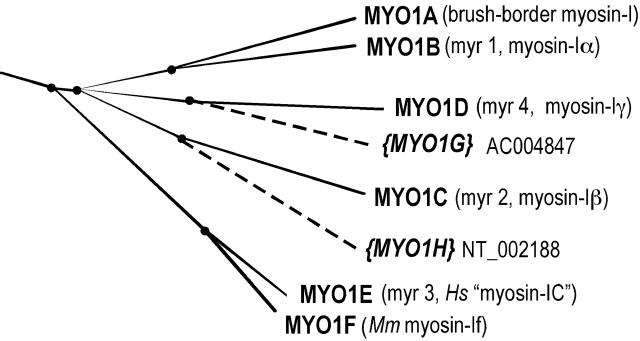Abstract
We suggest that the vertebrate myosin-I field adopt a common nomenclature system based on the names adopted by the Human Genome Organization (HUGO). At present, the myosin-I nomenclature is very confusing; not only are several systems in use, but several different genes have been given the same name. Despite their faults, we believe that the names adopted by the HUGO nomenclature group for genome annotation are the best compromise, and we recommend universal adoption.
In the HUGO system (http://www.gene.ucl.ac.uk/nomenclature/), the Homo sapiens myosin-I gene names are MYO1A, MYO1B,…, MYO1H; the corresponding protein products are MYO1A, MYO1B,…, MYO1H. The Mus musculus gene names are Myo1a, Myo1b,…, Myo1h; the corresponding protein products are Myo1a, Myo1b,…, Myo1h. Although these names do not reflect the subclass relationships between genes (MYO1A and MYO1B; MYO1C and MYO1H; MYO1D and MYO1G; and MYO1E and MYO1F are most closely related; Fig. 1), this system names all myosin-I genes and their protein products and is presently being used to annotate the human and mouse genomes. The HUGO names are reconciled with other naming systems used for myosin-I gene products in Table I.
Figure 1.
Tree for human myosin-I genes. From Berg et al. (2001). Two recently predicted myosin-I genes are italicized, with the gene names suggested for them indicated in brackets.
Table I. Reconciliation of myosin-I names in the literature.
| Human gene | Human synonyms | Mouse gene | Mouse synonyms | Rat synonyms |
|---|---|---|---|---|
| MYO1A | Brush-border myosin-I (AF009961); “myosin-IA” (L29137) |
Myo1a | ||
| MYO1B | “myosin-IB” (L29138) | Myo1b | myosin-Iα (P46735); MIHC-L (X69987) | myr 1 (X68199); MI-130K |
| MYO1C | Myo1c | myosin-Iβ (X98507) | myr 2 (X74800); MI-110K | |
| MYO1D | Myo1d | myosin-Iγ (C45438) | myr 4 (X71997) | |
| MYO1E | “myosin-IC” (U14391) | Myo1e | myr 3 (X74815) | |
| MYO1F | “myosin-ID” (U57053); “myosin-IE” (X98411) |
Myo1f | myosin-If (X97650) | |
| MYO1G | Myo1g | |||
| MYO1H | Myo1h |
Table adapted from Berg et al. (2001).
We recommend those working with other vertebrates adopt the mouse names (upper case for the first letter, lower case for the rest), if appropriate modifying the gene or protein name using an abbreviation for the Latin binomial (e.g., Rc for Rana catesbeiana, Xl for Xenopus laevis). For example, myr 1—a rat myosin—would now be named Rn Myo1b (or just Myo1b).
To provide continuity with the previous literature, we suggest that common names be mentioned the first time that the gene or protein is mentioned; after that point, however, only the systematic name should be used.
Finally, although we have focused on the myosin-I family, we recommend that those working on other myosin families follow a similar naming convention.
References
- Berg, J.S., B.C. Powell, and R.E. Cheney. 2001. A millennial myosin census. Mol. Biol. Cell. 12:780–794. [DOI] [PMC free article] [PubMed] [Google Scholar]



